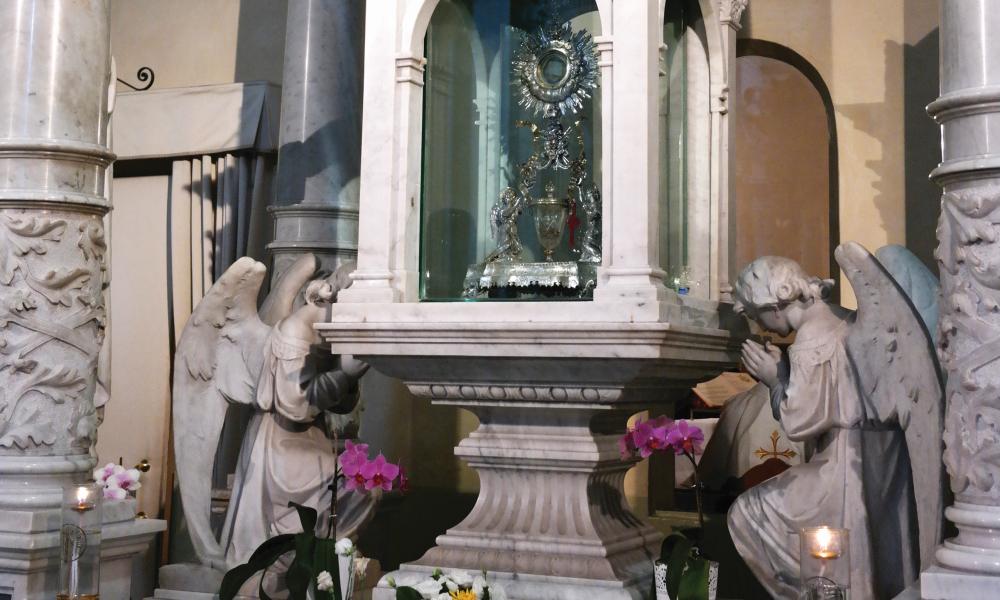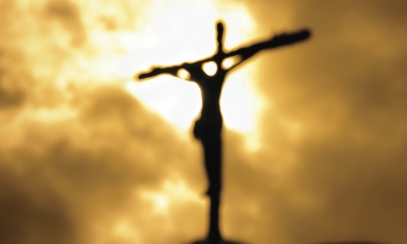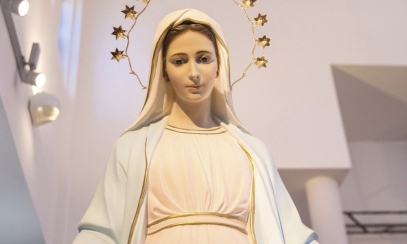
“Containers of the Uncontained God”
“The more Eucharist we receive, the more we become like Jesus so that on this earth we will have the foretaste of Heaven.” – Blessed Carlo Acutis (1991-2006)
“The more Eucharist we receive, the more we become like Jesus so that on this earth we will have the foretaste of Heaven.” – Blessed Carlo Acutis (1991-2006)
You return to your pew after receiving Holy Communion and close your eyes, thanking Jesus for coming to you in such an intimate way, humbly disguised as bread and wine. Suddenly, you open your eyes and behold a startling scene. Almost everyone in the Church has a red glass lamp hovering over them, with a candle flame flickering atop their heads. “What in heaven’s name can this mean?”
Such a mystical experience would actually point to a profound truth. Namely, that for about five or 10 minutes after we receive Communion, we are truly living tabernacles. (A tabernacle is the special receptacle where consecrated hosts are kept.) And just like the tabernacle in a Catholic church has a sanctuary lamp nearby to indicate Jesus’ Real Presence in the Blessed Sacrament, the same kind of lamp could rightly be placed near us when we receive the Sacred Host or the Lord’s Precious Blood. Jesus is the Second Person of the Holy Trinity made man – the One through whom all things were made.
So what an ancient Byzantine hymn says about Mary bearing the Lord in her womb is also true of us right after Communion: at that moment, each of us is a “container of the uncontained God.” This is a powerful perspective to offer when someone says, “Mass is boring.” In truth, Mass is miraculous!
But isn’t God always dwelling in a baptized person as long as she or he avoids grave sin and remains in friendship with God? Yes, absolutely. The Holy Trinity dwells in all the baptized as in a Temple as long as we remain in the state of grace. But the unique presence of the risen Christ – with his resurrected body, blood and human soul – only remains with us for five or 10 minutes after Communion. Once that which appears to our eyes as bread breaks down within us, the eucharistic presence of Jesus is no longer with us. It is no wonder that there is always a sacred hush that comes over the congregation after Holy Communion. In these moments, the Lord who conquered death by death is truly within us!
Science and the Eucharist
Our five senses – sight, touch, hearing, smell and taste – are great gifts from God. In general, we depend on our senses to lead us to the truth about reality – but they are not infallible. Bishop Robert Barron has pointed out how our experience of stars is similar to our experience of the Eucharist. Our sense of sight tells us that a particular star exists as we behold it sparkling in the night sky, but science explains that some of the stars we see do not actually exist anymore. Here, our senses betray our perception of reality. Similarly, when a bishop or priest prays the words of consecration at Mass (“This is my body…this is my blood,” etc.), our eyes still see bread and wine, and our taste buds still perceive bread and wine at Communion time. One of the greatest hymns to the Eucharist is the Tantum ergo, attributed to St. Thomas Aquinas. It begins: “Down in adoration falling / Lo! the sacred Host we hail.” But then we sing: “Faith for all defects supplying, / Where the feeble senses fail.” Our senses can let us down, sometimes, and this is the case when it comes to the Eucharist.
From the beginning, the Church has echoed Jesus’ insistence that the Eucharist is truly his most sacred Body and Blood, that “unless you eat the flesh of the Son of Man and drink his blood, you do not have life within you. Whoever eats my flesh and drinks my blood has eternal life, and I will raise him on the last day. For my flesh is true food, and my blood is true drink” (Jn 6:53-55). After Jesus spoke these words, many left because they found his teaching too difficult. If Jesus was only speaking symbolically, he would have been bound in justice and charity to call them back. Instead, he let them walk away. Fewer than eighty years after Jesus ascended into heaven, St. Ignatius (Bishop of Antioch and the first to call the Church “Catholic”) beautifully articulated our faith in the Real Presence of Jesus in the Eucharist. He wrote: “I desire the bread of God, which is the flesh of Jesus Christ, who was of the seed of David; and for drink I desire his blood, which is love incorruptible” (Letter to the Romans).
Science and the Miracle of Lanciano
I’m a big fan of science. Yet, in some ways, modern empirical science has almost become a new religion. “Follow the science” easily usurps the first commandment’s call to follow the Lord and worship him alone. We are still very much children of the Age of Enlightenment, summed up by a scene that took place after the French Revolution in 1789. To usher in a new age without religion, an actress or prostitute was dressed as the “Goddess of Reason” and placed on the altar of Notre Dame Cathedral to be the new object of adoration. Ever since, reason and science have taken a central place in the western world. That is why it is so powerful when science itself points to the truths of the Catholic faith. And this is the case with a Eucharistic miracle that took place in Lanciano, Italy around 750 A.D.
A monk there was celebrating Mass. Unfortunately, he struggled with doubts about what the Church teaches regarding Christ’s Real Presence in the Eucharist. He said the words of consecration, and when he uttered “This is my body,” the bread turned visibly into flesh. And when he prayed, “This is my blood,” the wine turned visibly into blood. Fifteen years ago, I visited this town and saw the flesh and blood with my own eyes. As Jeannette Williams notes in “The Amazing Science of Recent Eucharistic Miracles,” the “coagulated substance is human blood…with the same protein distribution as found in normal, fresh blood. …Like the blood, the flesh is also fresh, living tissue, because it ‘responded rapidly to all the clinical reactions distinctive of living beings.’” Science cannot explain how the flesh and blood still remain in their original, natural state after 12 centuries.
An article on the Aleteia website, “4 Incredible Eucharistic Miracles that Defy Scientific Explanation,” describes how “in 1970-71 and again in 1981, a scientific investigation was led by the scientist Odoardo Linoli, professor of anatomy and pathological histology and in chemistry and clinical microscopy.” The scientists concluded that “the flesh is cardiac tissue which contains arterioles, veins and nerve fibers. The blood type (in unison with all other approved Eucharistic miracles) was discovered to be type AB.” According to Zenit, the “Higher Council of the World Health Organization appointed a scientific commission to verify the Italian doctor’s conclusions. The work was carried out over 15 months with a total of 500 examinations… [and confirmed] science’s inability to explain the phenomenon.”
With many Catholics struggling to believe in the Real Presence of Jesus in the Eucharist, the testimony of science about miracles like the one in Lanciano can be a great help to people’s faith. The computer wiz, Carlo Acutis – who was beatified in 2020 – saw the value of sharing these miracles. Before he died from leukemia at age 15, he created a website on this topic (including in English): www.miracolieucaristici.org.
The finding that the miraculous flesh in Lanciano is cardiac tissue recalls the traditional Catholic devotion to the Sacred Heart of Jesus. And the AB blood type seems very significant – as my wife, LeAnne, pointed out to me. We might expect the blood type would be O negative, the universal giver. But AB is called “the universal recipient” which, in a sense, changes all blood types into itself. This connects closely with what happens at Holy Communion: Christ kindly makes us more like himself when we worthily receive him.
May Mother Mary help our faith in the Real Eucharistic Presence of Jesus grow, just as her son grew in her womb before his birth in Bethlehem, whose name means “House of Bread.”
Dr. Dan Osborn is director of the Center for Ministry for the Catholic Diocese of Saginaw



